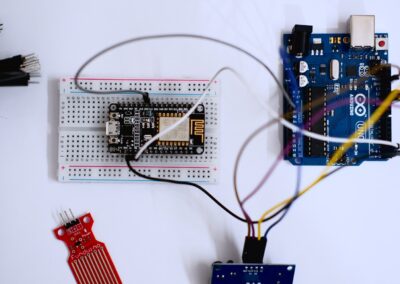The Importance of Secure Update Server Infrastructure
Enhancing IoT Security with Robust Update Servers
Establishing a secure update server infrastructure is crucial for protecting IoT firmware updates, ensuring the integrity and security of connected devices. As IoT devices become integral to smart cities like Riyadh and Dubai, safeguarding these updates against potential cyber threats is paramount. Secure update servers act as the backbone for distributing firmware updates, providing a trusted source for device improvements and security patches.
By implementing a secure update server infrastructure, organizations can mitigate the risks associated with unauthorized access and tampering. Secure servers use encryption and authentication protocols to verify the legitimacy of firmware updates, ensuring that only authorized updates are installed on devices. This process involves using cryptographic techniques such as digital signatures and secure hashing algorithms to validate the integrity of the update files.
For business executives and mid-level managers in regions like the UAE, understanding the importance of secure update servers is vital. This knowledge helps them make informed decisions about their IoT deployments, ensuring that their devices remain secure and reliable. A robust update server infrastructure not only protects the devices but also maintains the overall security posture of the interconnected systems that rely on accurate and secure device operation.
Implementing Best Practices for Secure Firmware Updates
To effectively protect IoT firmware updates, organizations must adopt best practices for establishing a secure update server infrastructure. One fundamental practice is to use encrypted communication channels, such as HTTPS, to transmit firmware updates from the server to the devices. This ensures that the data remains confidential and protected from interception during transit.
Another critical practice is to implement multi-factor authentication (MFA) for accessing the update servers. MFA adds an extra layer of security by requiring multiple forms of verification before granting access to the servers. This reduces the risk of unauthorized access, even if one form of authentication is compromised. Additionally, organizations should regularly update and patch their update server software to protect against known vulnerabilities and emerging threats.
Ensuring the update server infrastructure is scalable and resilient is also essential. This involves deploying redundant servers and load balancing mechanisms to handle high traffic and prevent single points of failure. By distributing the load across multiple servers, organizations can ensure that their IoT devices receive timely updates, even during peak usage periods. For entrepreneurs and business leaders, these practices are crucial in maintaining the reliability and security of their IoT systems.
Key Measures to Secure Update Servers
Securing update servers requires a comprehensive approach that includes physical, network, and application-level security measures. Physically securing the servers involves restricting access to the server rooms and using security controls such as surveillance cameras and access logs. This prevents unauthorized personnel from tampering with the servers or accessing sensitive information.
At the network level, organizations should implement firewalls and intrusion detection systems (IDS) to monitor and control incoming and outgoing traffic. Firewalls can block unauthorized access attempts, while IDS can detect and alert administrators to potential security breaches. Additionally, using virtual private networks (VPNs) for remote access to the update servers can further enhance security by encrypting the communication channels.
Application-level security measures include regularly auditing the server software for vulnerabilities and applying security patches promptly. Organizations should also use secure coding practices to minimize the risk of exploitation by attackers. For example, validating user inputs and sanitizing data can prevent common web application attacks such as SQL injection and cross-site scripting (XSS).
By implementing these key measures, organizations can create a secure update server infrastructure that protects IoT firmware updates from tampering and unauthorized access. For business executives in Saudi Arabia and the UAE, investing in these security measures is essential for maintaining the integrity and reliability of their IoT deployments.
Case Studies: Successful Implementation of Secure Update Servers
Smart City Initiatives in Dubai
Dubai’s smart city initiatives provide a compelling example of successfully implementing a secure update server infrastructure. The city has deployed numerous IoT devices across various sectors, including transportation, energy, and public safety. To protect these devices from tampering, Dubai has adopted comprehensive encryption strategies, ensuring that all firmware updates are securely delivered through encrypted communication channels.
One notable application is the city’s intelligent transportation system, which relies on interconnected sensors and devices to manage traffic flow and reduce congestion. By establishing a secure update server infrastructure, Dubai has safeguarded its transportation network from potential cyber-attacks, ensuring a reliable and efficient system for its residents. The use of multi-factor authentication and regular security audits has further strengthened the security of the update servers.
Healthcare IoT Security in Riyadh
In Riyadh, healthcare facilities have leveraged IoT technologies to improve patient care and operational efficiency. However, the sensitive nature of medical data and the critical functions of medical devices necessitate stringent security measures. To address this, Riyadh’s healthcare providers have implemented robust encryption for all IoT firmware updates, ensuring that devices operate securely and reliably.
For instance, connected medical devices such as infusion pumps and patient monitoring systems are equipped with firmware that is updated through secure servers. These servers use encrypted communication channels and digital signatures to verify the authenticity of the updates. By adopting these practices, Riyadh’s healthcare facilities have enhanced the security of their IoT systems, safeguarding patient data and improving overall care quality.
Business Success through IoT Security in Saudi Arabia
Across Saudi Arabia, businesses have recognized the importance of IoT security in achieving long-term success. Companies in sectors such as manufacturing, logistics, and retail have implemented secure update server infrastructures to protect their IoT devices from tampering and cyber threats. These efforts have not only enhanced security but also improved operational efficiency and customer trust.
For example, a leading logistics company in Saudi Arabia has deployed IoT devices to monitor and manage its fleet of vehicles. By establishing a secure update server infrastructure and implementing encrypted communication channels, the company has ensured the integrity of its fleet management system. This has resulted in improved route optimization, reduced fuel consumption, and enhanced overall operational efficiency, demonstrating the tangible benefits of robust IoT security.
In conclusion, establishing a secure update server infrastructure is critical for protecting IoT firmware updates and ensuring the reliability of connected devices. By adopting best practices for secure firmware updates and implementing comprehensive security measures, organizations can safeguard their IoT systems from potential threats. Case studies from Dubai, Riyadh, and Saudi Arabia highlight the successful implementation of these strategies, demonstrating their importance in achieving business success and maintaining the integrity of IoT deployments.
—
#IoTSecurity #FirmwareUpdates #SecureUpdateServers #Cybersecurity #SaudiArabia #UAE #Riyadh #Dubai #ArtificialIntelligence #Blockchain #GenerativeAI #ModernTechnology #BusinessSuccess #LeadershipSkills #ProjectManagement































